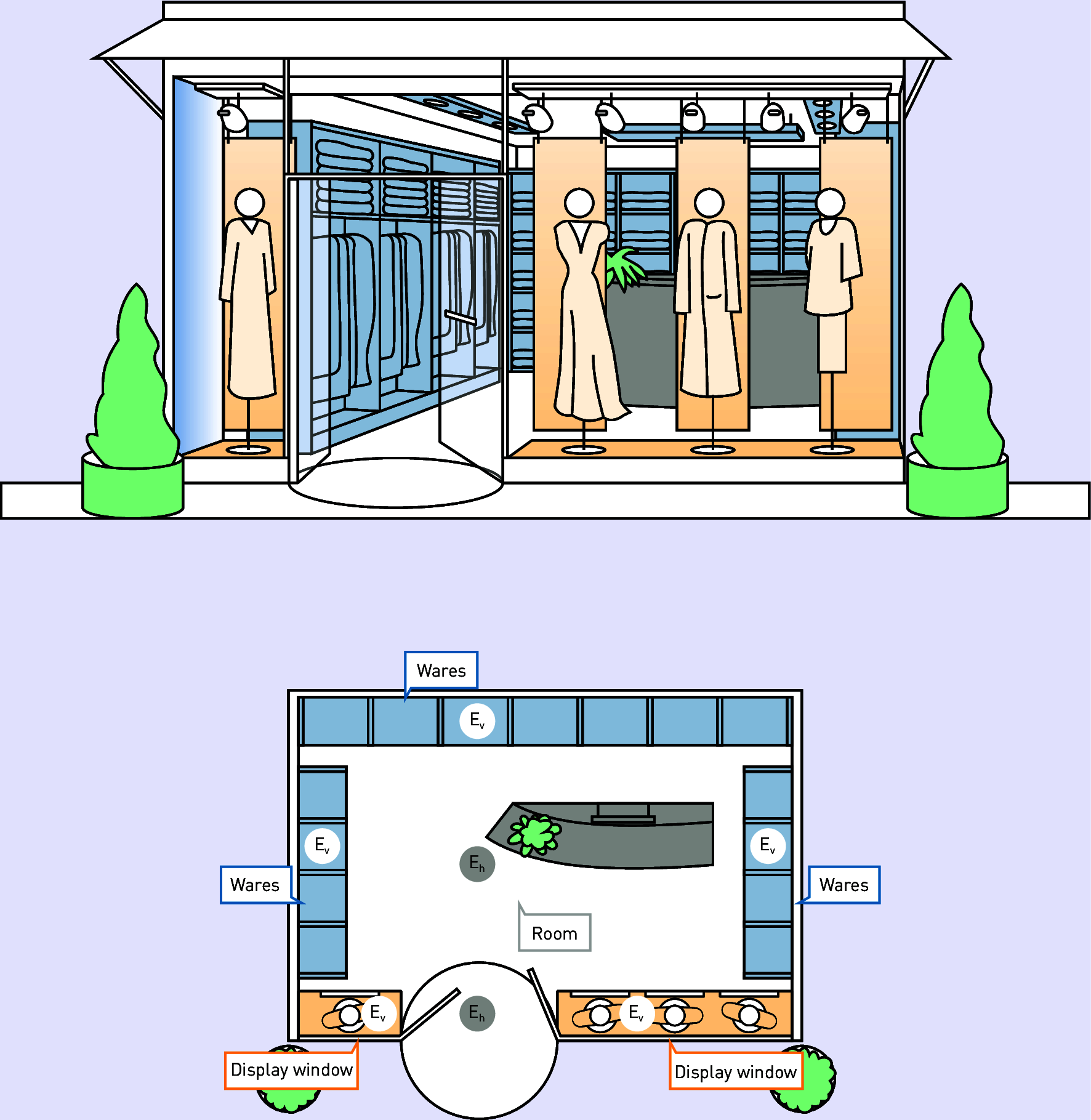Fundamentally, the following applies: To optically steer customers into the retail space, it must be illuminated more brightly than the outside, meaning the area where the customer is currently located.
Lighting design
Thus, the focal point of attention supported by bright lighting is the shop window, closely followed by the entrance to the saleroom, and the brightly lit merchandise presented when it is possible to see the retail space from the entrance. Studies show: the brighter a shop window, the more people will stop in front of it. This means attractiveness increases with lighting levels.
The level of lighting in retail spaces thus directly depends on outside brightness: a dark shop window during the day will not attract attention. A dark entrance will not see traffic, and the direct view into a retail space that is dark compared to the outside brightness will not attract customers.
On bright days, it is only rarely possible to exceed the outside level of light with shop window, entrance and saleroom lighting, for both economic and merchandise conservation-related reasons. Still, "daytime lighting" should be bright enough to attract a certain measure of attention. However: Shop windows that reflect pronounced sun or sky or mirror traffic and buildings on the opposite side of the road cannot acheive this. Presented merchandise is hardly noticable. Here, it is necessary to create shade, e.g. by using awnings.
In darkness, the situation improves considerably: The desired customer attention can be triggered by significantly higher levels of illumination within the saleroom compared to the outside, even when using lower levels of light than during the day. In shopping malls,the brightness of the pedestrian walkways does not change as much as it does outside, e.g. in a non-canopied pedestrian zone, so the illuminance can remain the same over the entire shopping period.
Due to experience regarding accepted luminance relations, the illuminance values contained in figure 5.68 for shop windows, store entrances and the most important areas in the saleroom can be deduced: Based on an extremely bright day with an outside illuminance of 100.000 lx which is reduced to 30.000 lx using an awning, shop windows should be illuminated at a vertical illuminance Ev between 1.000 lx and 1.500 lx, depending on the reflectance of the presented merchandise. In order to trigger the desired customer attention, a horizontal illuminance Eh between 1.500 lx and 2.000 lx is recommended for the entrance area.
Further information on designing and implementing lighting in retail spaces can be found in chapter "Lighting design", section "Light and accents" as well as issue 6 of the series "licht.wissen" published by the sector initiative licht.de.
It is very important to pay close attention to possible colour distortions caused by unsuitable light source spectrums or reflections on coloured walls, furniture, canopies or awnings – particularly in the merchandise presentation areas – which could cause misleading colour perceptions. For example, the merchandise in clothing stores should be judged under illumination with the light colour that dominates the situations in which the products are usually worn: warm-white lighting for evening wear, daylight-white lighting for daytime wear.
Regarding possible impacts on the appearance of meat and meat products, and for specifications of lamps in meat and meat product lighting. see chapter "Lighting of industrial and handcraft work places", section "Food and luxury foods". The spectrum of special lamps for lighting meat displays usually contains an elevated red component to make the meat appear fresh. These special light colours are only to be used for goods presentation, but not for general salesroom lighting.
Besides realistic colour perception of foods, the damaging effects of artificial lighting radiation on foodstuffs is a central lighting characteristic. It is effectively avoided by using LED lighting, since LED radiation does not contain infrared or ultraviolet components (see chapter "Light sources").
Damaging impacts on displayed goods are effectively avoided by using LED lighting, since their radiation is nearly free of infrared or ultraviolet components. The most important characteristics of LED (details see chapter "Light sources") are:
long service life of up to 50.000 h, compared to: fluorescent lamps with up to 18.000 h or tungsten halogen lamps with up to 2.000 h;
high luminous efficacy (exceeding lm/W);
good to excellent colour rendering (up to Ra = 90);
adjustable luminous flux and thus illuminance; and
light colour variations over a great range.
In practice, the long service life of LED luminaires means that replacement only becomes necessary after 18 years assuming 11 hours of operation per day and 250 days of operation per year.
LED luminaires are the standard in food lighting today. Besides their use in general lighting of retail spaces, they are integrated in refrigeration units, e.g. for dairy products or packaged meat and cold cuts or cheeses. They are also perfect for appetising display of fruit, vegetables or baked goods.
The diverse natural colours of fruit and vegetables, for example, demand warm light colours. The freshness of red fish can be emphasised using warm light tones, while cool light serves to showcase fresh white fish. In meats and cold cuts with large red portions, the white of the fat portions must remain visible. Warm light colours are suitable for yellowish cheeses, while a cooler light colour is required for cheeses with a whiter appearance. Baked goods require warm light colours, and cream cakes require white light.


Figure 3.147: Sales-promoting illuminance levels in relation to outside brightness: Ev is the average vertical illuminance, Eh is the average horizontal illuminance in lx. Inside the retail space, horizontally and vertically arranged merchandise presentations must be illuminated correspondingly brightly to attract attention and trigger desire.